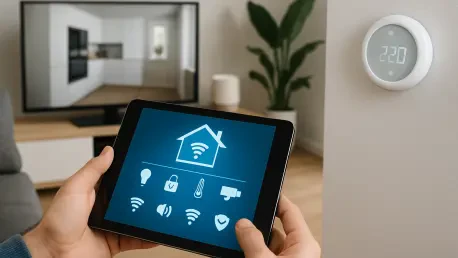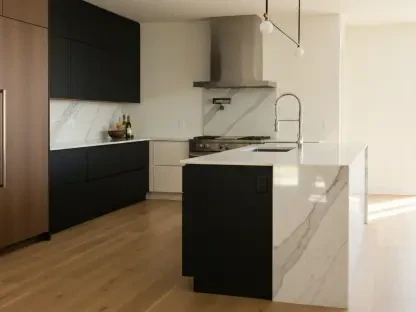The smart home platforms market is experiencing a transformative surge, reshaping how individuals interact with their living spaces through cutting-edge technology. This sector focuses on integrated software and hardware ecosystems that allow users to monitor, automate, and manage household devices like lighting, security systems, heating, ventilation, air conditioning (HVAC), and appliances. By leveraging advanced tools such as the Internet of Things (IoT), Artificial Intelligence (AI), and voice assistants, these platforms provide unmatched convenience, enhanced security, and improved energy efficiency to both residential and commercial environments. Valued at $20.04 billion in 2024, the market is projected to soar to $96.85 billion by 2034, growing at a compound annual growth rate (CAGR) of 17.07% from 2025 onward, signaling a significant shift in consumer behavior toward connected living solutions. This expansion is driven by a growing demand for smarter, safer, and more sustainable homes, reflecting wider trends in technology adoption and lifestyle evolution. As these platforms become increasingly integrated into daily life, understanding the drivers, challenges, and regional dynamics behind this growth offers vital insight into the future of modern living. This exploration examines the forces propelling the market forward, from innovative breakthroughs to changing consumer needs, while also addressing the obstacles that could slow this remarkable rise.
Explosive Growth and Market Projections
The smart home platforms market is on an extraordinary upward trajectory, with its valuation expected to climb from $23.45 billion in 2025 to an impressive $96.85 billion by 2034. This growth, supported by a robust CAGR of 17.07% over the forecast period, highlights the increasing reliance on connected technologies to improve daily living. Consumers are investing more in solutions that emphasize security, convenience, and sustainability, pushing the limits of what homes can achieve. The figures reflect not just a trend but a fundamental change in how living spaces are perceived and used, driven by the integration of smart devices into everyday routines. As more households adopt these technologies, the market’s expansion signals a broader acceptance of automation and remote control as standard features of modern life. This momentum is bolstered by advancements that make such systems more accessible and appealing to a diverse range of users worldwide.
Beyond the headline numbers, the market’s growth is shaped by distinct regional contributions that highlight varying levels of adoption and infrastructure readiness. North America led the way in 2024 with a commanding 40% market share, largely due to its advanced technological landscape and significant consumer spending power on smart solutions. Meanwhile, Asia Pacific is set to become the fastest-growing region, driven by rapid urbanization and government-backed smart city initiatives that promote the integration of intelligent systems. These regional differences illustrate a complex tapestry of growth drivers, where economic conditions, cultural acceptance, and policy support play crucial roles. The interplay of these factors suggests that while the global market is unified in its upward trajectory, the pace and nature of growth vary widely, offering unique opportunities and challenges in each area.
Innovations Driving Technological Transformation
At the heart of the smart home platforms market’s rapid expansion lies a wave of technological innovation, particularly through the integration of IoT and AI. IoT serves as the foundation, enabling seamless connectivity among devices so users can manage their homes remotely with ease. AI takes this further by personalizing experiences, learning user preferences, and optimizing functions like energy consumption through predictive algorithms. For instance, AI can adjust lighting or temperature based on occupancy patterns, enhancing both comfort and efficiency. These advancements are not merely incremental but transformative, making smart homes more intuitive and responsive to individual needs. As technology continues to evolve, the sophistication of these platforms is expected to increase, further embedding them into the fabric of daily life and driving market demand.
Voice assistants, such as Amazon Alexa and Google Assistant, have emerged as key components in this technological ecosystem, acting as central hubs for controlling connected devices. Holding a dominant 38% market share in 2024, smart speakers and voice assistants exemplify the consumer preference for hands-free operation and streamlined interaction with home systems. Their ability to integrate with a wide array of devices—from thermostats to security cameras—has made them indispensable in modern smart homes. This segment’s prominence reflects a broader trend toward accessibility, where ease of use becomes a key selling point. As developers refine these technologies, incorporating more natural language processing and contextual understanding, the user experience is likely to become even more seamless, reinforcing the appeal of smart home platforms across diverse demographics.
Rising Consumer Needs for Ease and Safety
Modern consumers are increasingly drawn to the convenience offered by smart home platforms, which automate routine tasks and fit effortlessly into fast-paced lifestyles. The ability to control lighting, appliances, or door locks through a smartphone app or voice command eliminates manual effort and saves time. This demand for streamlined living is a major force behind the market’s growth, as more individuals seek solutions that simplify household management. The appeal lies in the adaptability of these systems, which cater to a variety of needs, from scheduling routines to providing real-time updates on home status. As urbanization continues to rise, the necessity for such efficient tools becomes even more pronounced, positioning smart home platforms as essential components of contemporary living spaces.
Security concerns also play a critical role in driving the adoption of smart home technologies, as homeowners prioritize safety in an uncertain world. Smart cameras, advanced locks, and integrated security systems offer real-time monitoring and instant alerts, providing peace of mind whether users are at home or away. The growing emphasis on protecting personal spaces has transformed these features from optional extras into must-have necessities, fueling market expansion. Unlike traditional security measures, these connected devices allow for remote access and anomaly detection, ensuring a proactive approach to safety. This shift reflects broader societal trends where technology is leveraged to address fundamental human needs, further solidifying the relevance of smart home platforms in meeting both practical and emotional priorities of consumers.
Sustainability as a Market Catalyst
Energy efficiency stands out as a compelling motivator in the smart home platforms market, with consumers increasingly adopting solutions that reduce waste and lower utility costs. Smart thermostats, automated lighting, and energy management systems work together to optimize consumption, adjusting settings based on usage patterns or environmental conditions. This not only benefits individual households by cutting expenses but also contributes to broader environmental goals by minimizing energy footprints. The alignment with sustainability trends has made these platforms attractive to eco-conscious buyers who view technology as a means to live more responsibly. As awareness of climate issues grows, the role of smart homes in promoting greener lifestyles is expected to become even more significant, driving further market penetration.
Government policies and incentives amplify this trend by encouraging the adoption of energy-efficient technologies through subsidies and tax benefits. Such support aligns with global efforts to combat climate change and build sustainable infrastructure, positioning smart home platforms as vital tools in green building initiatives. Many regions offer financial incentives for retrofitting homes with energy-saving devices, making the transition to smart systems more accessible to a wider audience. This synergy between public policy and private innovation creates a fertile ground for market growth, as it addresses both economic and ecological imperatives. The focus on sustainability not only enhances the appeal of smart home platforms but also ensures their relevance in a world increasingly focused on preserving resources for future generations.
Regional Insights and Emerging Hotspots
North America’s leadership in the smart home platforms market is evident, with the U.S. alone valued at $5.61 billion in 2024 and projected to reach $27.65 billion by 2034. This dominance stems from a tech-savvy consumer base, robust infrastructure, and substantial investments by industry giants like Amazon and Google. The region’s emphasis on energy-efficient retrofits and smart building standards further cements its position at the forefront of adoption. High disposable incomes and a cultural inclination toward early technology adoption also contribute to this trend, making North America a benchmark for market maturity. As innovation continues to thrive here, the region serves as a testing ground for new features and integrations that often set global standards for the industry.
In contrast, Asia Pacific is emerging as the fastest-growing region, propelled by rapid urbanization, expanding internet access, and ambitious smart city projects. Initiatives like India’s Smart Cities Mission, with investments exceeding $19.8 billion, highlight the region’s commitment to integrating smart technologies into urban development. Countries such as China, Japan, and South Korea are also key contributors, driven by government support and a burgeoning middle class eager for connected solutions. This dynamic growth underscores the potential for Asia Pacific to reshape the global market landscape, as increasing affordability and infrastructure improvements make smart home platforms more accessible. The region’s trajectory suggests a future where emerging markets play a pivotal role in defining the scope and scale of smart home adoption worldwide.
Navigating Challenges in Market Expansion
Despite the promising outlook, the smart home platforms market faces significant hurdles that could temper its growth. High initial costs remain a primary barrier, as the upfront investment for comprehensive systems can be prohibitive for many potential buyers, particularly in lower-income segments. While prices are gradually decreasing due to economies of scale and technological advancements, affordability continues to be a sticking point for widespread adoption. This challenge is compounded in regions where disposable income is limited, highlighting the need for innovative pricing models or financing options to bridge the gap. Addressing cost concerns will be essential to ensure that the benefits of smart homes are not restricted to higher-income demographics.
Data privacy issues also pose a substantial challenge, as the interconnected nature of smart devices raises concerns about security breaches and unauthorized access to personal information. Consumers are increasingly wary of how their data is collected, stored, and used, which can dampen enthusiasm for adopting these technologies. Additionally, the complexity of installing and configuring smart systems may deter less tech-savvy individuals, creating another layer of resistance. Overcoming these obstacles requires a concerted effort from industry stakeholders to enhance security protocols, simplify user interfaces, and educate consumers on the benefits and safeguards of smart home platforms. Tackling these issues head-on will be crucial to maintaining trust and sustaining the market’s upward momentum in the long term.
Shaping the Future of Connected Living
Looking back, the journey of the smart home platforms market reveals a landscape defined by rapid innovation and evolving consumer expectations. The valuation had already reached $20.04 billion in 2024, setting a strong foundation for the projected leap to $96.85 billion by 2034. Technological advancements in AI and IoT had reshaped homes into intelligent ecosystems, while consumer demand for convenience and security had driven unprecedented adoption rates. Regional disparities, with North America’s dominance and Asia Pacific’s swift rise, had illustrated the diverse yet interconnected nature of global growth. Challenges like high costs and privacy concerns had emerged as critical hurdles, yet the industry had shown resilience through continuous improvements and policy support.
Moving forward, stakeholders must focus on actionable strategies to maintain this momentum, such as developing cost-effective solutions to broaden market access and prioritizing robust data protection measures to build consumer confidence. Collaboration between technology providers and policymakers could further accelerate growth by aligning smart home innovations with sustainability goals through targeted incentives. As the market continues to evolve, investing in user education and intuitive design will be key to overcoming adoption barriers. The future of connected living hinges on balancing innovation with accessibility, ensuring that the benefits of smart home platforms reach every corner of the globe while addressing the unique needs of diverse populations.









